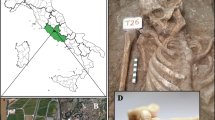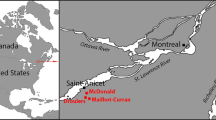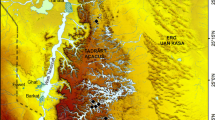Abstract
Ancient Maya believed in life after death. They used to prepare dead bodies during burial ceremonies whose purpose was to celebrate the dead and to help them passing through the way from earthly life to the beyond one. Bodies preparation included coloured scented body ointment application, with a deep symbolic connotation and probably also a conservative purpose. The aim of this research was to characterize pigments and binders used by ancient Maya in the preparation of body ointments used to paint human bones. Emblematic painted bone samples from Xcambó (Maya archaeological site located in the municipality of Dzemul, in the Mexican state of Yucatán) were investigated through a non-destructive and micro-destructive analytical techniques. Results pointed out the presence of two mainly red pigments, i.e. red ochre and cinnabar, as already observed in other Maya painted bones. The new insight of the research is the identification of the organic compounds used as binding media in the ointments: a mixture of vegetable drying oil (probably Chia seed oil) mixed with an aromatic compound (bitumen). This knowledge, together with that obtained in the last decades, is important to reconstruct the cultural habitat and social customs of this pre-Hispanic civilization and transfer them to today’s context.
Graphical abstract












Similar content being viewed by others
References
Rigon C, Izzo FC, Vázquez de Ágredos Pascual ML, Campíns-Falcó P, Van Keulen H (2020) New results in ancient Maya rituals researches: the study of human painted bones fragments from Calakmul archaeological site (Mexico), J Archaeol Sci
Sommer M (2008) Bones and ochre. The curious afterlife of the Red Lady of Paviland. Hardcover, Harvard
Batta E, Argáez C, Mansilla J, Pijoan C, Bosch P (2012) On yellow and red pigmented bones found in Maya burials of Jaina. J Archaeol Sci 1-11
Cervini-Silva J, Palacios E, María De Lourdes, Ángel PD, Montoya JA, Ramos E, López F, Pacheco AR (2012) Cinnabar preserved bone structure from primary osteogenesis and fungal signatures in ancient human remains. Geomicrobiol J 30:566-577
Hovers E, Ilani S, Bar-Yosef O, Vandermeersch B (2003) An early case of symbolism: ochre use by modern humans in Qafzeh Cave. Curr Anthropol 44(4):491–522
Quintana Owen P, Tiesler V, Conde M, Trejo-Tzab R, Bolio C, Alvarado Gil JJ, Aguilar D (2014) Spectrochemical characterization of red pigments used in Classic period Maya funerary practices. Archaeometry
Wreschner EE, Bolton R, Butzer KW, Delporte H, Hausler A, Heinrich A, Jacobson-Widding A, Malinowski T, Masset C, Miller SF, Ronen A, Solecki R, Stephenson PH, Thomas LL, Zollinger H (1980) Red ochre and human evolution: a case for discussion [and comments and reply]. Curr Anthropol 21(5):631–644
Attard Montalto N (2010) The characterisation and provenancing of ancient ochres. Unpublished PhD thesis, Cranfield University, United Kingdom
Vázquez de Ágredos-Pascual ML (2018a) Painting the skin in ancient Mesoamerica. In: Painting the skin: pigments on bodies and codices in pre-Columbian Mesoamerica, edited by Élodie Dupey García y Ma. Luisa Vázquez de Ágredos Pascual, pp.11–23, University of Arizona Press-Universidad Nacional Autónoma de México
Arriaza Bernardo T (1995) Beyond death: the Chinchorro mummies of ancient Chile. Smithsonian Institution Press, Washington DC
Dillehay T (ed) (1995) Tombs for the living, Andean mortuary practice: a symposium at Dumbarton Oaks. Dumbarton Oaks Research Library and Collection, Washington DC
Vázquez de Ágredos Pascual, Mª Luisa, Cristina Vidal Lorenzo and Patricia Horcajada Campos, Christa Schieder de Lavarreda and Miguel Orrego Corzo, Las Fragancias Rituales del Preclásico en Tak´alik Ab´aj (2016a) In: The dimensions of rituality 2000 years ago and today, edited by Christa Schieber de Lavarreda and Miguel Orrego Corzo, pp. 30-35. Ministerio de Cultura y Deportes, Guatemala
Vázquez de Ágredos Pascual, Ma. Luisa, Cristina Vidal Lorenzo, Patricia Horcajada Campos, Vera Tiesler (2018b) Body color and aromatics in Maya funerary rites. In: Painting the skin: pigments on bodies and codices in pre-Columbian Mesoamerica, edited by Élodie Dupey García y Ma. Luisa Vázquez de Ágredos Pascual, pp.56–74, University of Arizona Press-Universidad Nacional Autónoma de México.
Tiesler V, Domínguez MR, Folan WJ, M Coyoc (2001) Los entierros: Funerarios y extra-funerarios. In Las ruinas de Calakmul, Campeche, México: Un lugar central y su paisaje cultural, edited by William J. Folan, Laraine A. Fletcher, Jacinto May Hau and Lynda Florey Folan, pp. 77–80. Universidad Autónoma de Campeche
Pincemin S (1994) Entierro en el Palacio: La tumba de la Estructura III, Calakmul, Campeche, Universidad Autónoma de Campeche, Campeche
Tiesler V, Andrea Cucina, Patricia Quintata Owen, Daniel H. Aguilar, Iván Oliva Arias, J. V. Cauich Rodríguez, William J. Folan, María del Rosario Domínguez Carrasco (2013) What’s on the bone? Interdisciplinary approaches in reconstructing the posthumous body treatment of the ancient Maya aristocracy of Calakmul, Campeche, Mexico. In The dead tell tales. Essays in Honor of Jane E. Buikstra, edited by María Cecilia Lozada and Barra O’Donnabhain. 85-94. Cotsen Institute of Archaeology Press, University of California
Pereira G, Michelet D (2004) Gobernantes Mayas en lechos de muerte: El caso de Balamkú, un patrón funerario del clásico temprano. In culto funerario en la sociedad maya. Memoria de la Cuarta Mesa Redonda de Plenque, edited by Rafael Cobos, pp. 333–368. Instituto Nacional de Antropología e Historia, Mexico City
Vázquez De Ágredos ML, Tiesler V, Pacheco AR (2015) Perfumando al difunto. Fragrancias y tratamientos póstumos entre la anigua aristocracia maya, Arqueología mexicana XXIII:135
Izzo FC, Zendri E, Bernardi A, Balliana E, Sgobbi M (2013) The study of pitch via gascromatography-mass spectrometry and Fourier-transformed infrared spectroscopy: the case of the Roman amphoras from Monte Poro, Calabria (Italy). J Archaeol Sci 40:595–600
Izzo FC, van den Berg KJ, van Keulen H, Ferriani B, Zendri E (2014) 20th century artists’ oil paints: the case of the Olii by Lucio Fontana. J Cult Herit 15:557–563
Fuster Lopez L, Izzo FC, Piovesan M, Yusa Marco DJ, Sperni L, Zendri E (2016) Study of the chemical composition and the mechanical behaviour of 20th century commercial artists’ oil paints containing manganese-based pigments. Microchem J 124:962–973
Izzo FC, Zanin C, van Keulen H, da Roit C (2017) From pigments to paints: studying original materials from the atelier of the artist Mariano Fortuny y Madrazo. Int J Conserv Sci 8:547–564
Caravà S, Roldán García Clodoaldo, Vázquez De Ágredos Pascual M. Luisa, Murcia Mascarós Sonia, Francesca C. Izzo, Investigtion of modern oil paints through a physico-chemical integrated approach. Emblematic cases from Valencia, Spain, Spectrochimica acta. Part A, Molecular and biomolecular spectroscopy, 2020, Vol.240
Lodi Giulia Carolina, Giuseppe Borsato, M. Luisa Vázquez De Ágredos Pascual, Francesca Caterina Izzo (2020) Disclosing the composition of unknown historical drug formulations: an emblematic case from the Spezieria of St. Maria della Scala in Rome, Analytical and Bioanalytical Chemistry
Van Keulen H, Schilling M (2019) AMDIS & Excel: a powerful combination for evaluating THM Py-GC/MS results from European lacquers. Stud Conserv 4(sup1):74–80
Bosch P, Alemán I, Moreno-Castilla C, Botella M (2011) Boiled versus unboiled: a study on Neolithic and contemporary human bones. J Archaeol Sci 38:2561–2570
Fernández-Jalvo Y, Dolores Marín Monfort M (2008) Experimental taphonomy in museums: preparation protocols for skeletons and fossil vertebrates under the scanning electron microscopy. Géobios 41:157–181
Papageorgopoulou C, Xirotiris NI, Iten PX, Baumgartner MR, Schmid M, Rühli F (2009) Indications of embalming in Roman Greece by Physical, chemical and histological analysis. J Archaeol Sci 36:35–42
Doménech- Carbó María Teresa, Vázquez de Ágredos Pascual Mª Luisa, Osete-Cortina Laura, Doménech- Carbó Antonio, Guasch-Ferré Núria, Manzanilla Linda R., Vidal-Lorenzo Cristina (2012) Characterization of prehispanic cosmetics found in a burial of the ancient city of Teotihuacan (Mexico). J Archaeol Sci 39:1043–1062
Vázquez De Ágredos Pascual ML, Manzanilla Linda R (2016b) Corporate paint and ancient pharmaceutical mixtures from Teotihuacan: the Teopancazco neighborhood center. Int J Pharmacovigil
Ávila A, Mansilla J, Bosch P, Pijoan C (2014) Cinnabar in Mesoamerica: poisoning or mortuary ritual? J Archaeol Sci 49:48–56
Picollo M, Aceto M, Vitorino T (2018) UV-VIS spectroscopy. Phys Sci Rev 4(4)
Lachowicz JI, Palomba S, Meloni P, Carboni M, Sanna G, Floris R, Pusceddu V, Sarigu M (2017) Multi analytical techniques study of human bones from an archaeological discovery. J Trace Elem Med Biol 40:54–60
Rajendran J (2011) Xanes and Ftir studies on dried and calcined bones, Master Degree thesis in Science in material science and engineering, University of Texas at Arlington
Lee-Thorp J (2002) Two decades of progress towards understanding fossilization processes and isotopic signals in calcified tissue minerals. Archaeometry 44(3):435–446
Bartošova A, Blinova L, Gerulová K (2015) Characterisation of polysaccharides and lipids from selected green algae species by FTIR-ATR spectroscopy, Research Papers. Faculty of Material Science and Technology. Slovak University of Technology in Trnava 23(36):97–102
Sivakumar S, Prasad KC, Sivasubramanian J (2014) Studies the alteration of biochemical and mineral contents in bone tissue of mus musculus due to aluminum toxicity and the protective action of desferrioxamine and deferiprone by FTIR, ICP-OES, SEM and XRD techniques. Spectrochim Acta A Mol Biomol Spectrosc 126:59–67
Gu C, Katti DR, Katti KS (2013) Photoacustic FTIR spectroscopic study of undisturbed human cortical bone. Spectrochim Acta A Mol Biomol Spectrosc 103:25–37
Dudd SN, Regert M, Evershed RP (1998) Assessing microbial lipid contributions during laboratory degradations of fats and oils and pure triacylglycerols absorbed in ceramic potsherds, Organic geochemistry 29, N.5–7:1345–1354
Lucero Gómez P., Mathe C., Vieillescazes C., Bucio L., Belio I., Vega R., Analysis of Mexican standards for Busera spp. resins by gas chromatography-mass spectrometry and application o archaeological objects, Journal of archaeological science, 2014, Vol.41, pp. 679–690
Sarret M, Adam P, Schaeffer P, Ebert Q, Perthuison J, Pierrat-Bonnefois G (2014) Organic substances from Egyptian jars of the Early Dynastic period (3100–2700 BCE): mode of preparation, alteration processes and botanical (re)assessment of “cedrium. J Archaeol Sci Rep 14:450–431
Regert M, Bland HA, Dudd SN, Van Bergen Pim F, Evershed Richard P (1998) Free and bound fatty acid oxidation products in archaeological ceramic vessels. Proc Royal Soc Biol Sci 265(1409):2027–2032
Kulczyński B, Kobus-Cisowska J, Taczanowski M, Kmiecik D, Gramza-Michalowska A (2019) The chemical composition and nutritional value of chia seeds – Current state of knowledge. Nutrients 11(6):1242
Ciftci ON, Przybylski R, Rudzińska M (2012) Lipid components of flax, perilla and chia seeds. Eur J Lipid Sci Technol 114(7):794–00
Nitrayová S, Brestenský M, Heger J, Patráš P, Rafay J, Sirotkin A (2014) Amino acids and fatty acids profile of chia/Salvia Hispanica L.) and flax (Linum usitatissium L.) seed. Potravinarstvo 8(1):72–76
Ayerza R (1995) Oil content and fatty acid composition of chia (Salvia Hispanica L.) from five northwestern locations in Argentina, Journal of American Oil Chemists’ Society, - Springer
Seher Von A, Schiller H, Krohn M, Werner G (1980) Untersuchungen von, Olprobencc aus archaologischen Funden, aus der Bundensanstalt fur Fettforsclzung, MiinsterlWestf
Connan J, Nissenbaum A, Imbus K, Zumberge J, Macko S (2006) Asphalt in iron age excavations from Phillistine Tel Miqne-Ekron city (Israel): origin and trade routes. Org Geochem 37:1768–1786
Burger Pauline, Stacey RJ, Bowden SA, Hacke M, Parnell J (2016) Identification, geochemical characterisation and significance of bitumen among the grave goods of the 7th century mound 1 ship-burial at Sutton Hoo (Suffolk, UK). PloS ONE 11(12)
Zhao HY, Cao Y, Sit SP, Lineberry Q, Pan W (2012) Thermal characteristics of bitumen pyrolysis. J Therm Anal Calorim 107(2):541–547
Languri GM, Van der Horst J, Boon JJ (2002) Characterisation of a unique “asphalt” sample from the early 19th Hafkenscheid painting materials collection by analytical pyrolysis MS and GC/MS. J Anal Appl Pyrolisys 63:171–196
Toshinari S, Yaguchi K, Suzuki S (2001) Monitoring of phthalic acid monoesters in river water by solid-phase extraction and GC-MS determination. Environ Sci Technol 35:3757–3763
López-Polín L Possible interferences of some conservation treatments with subsequent studies on fossil bones: a conservator’s review. Quaternary International 275:120–127
Piña-Torres C, Lucero Gómez P, Nieto S, Vázquez A, Bucio L, Belio I, Vega R, Mathe C, Vieillescazes C (2018) An analytical strategy based on Fourier transform infrared spectroscopy, principal component analysis and linear discriminant analysis to suggest the botanical origin of resins from Bursera. Application to archaeological Aztec Samples. J Cult Herit 33:48–59
Maldonado Cano D (2003) En el umbral: tanatopráxis contemporánea, edited by Andrés Ciudad Ruiz, Mario Humberto Ruz Sosa y Ma. Josefa Iglesias Ponce de León, 457–772, Sociedad Española de Estudios Mayas-Universidad Nacional Autónoma de México.
Vázquez de Ágredos Pascual ML (2009) El color y lo funerario entre los mayas. Ritual, magia y cotidianidad, Península IV: 61–73
Ruz Sosa MH (2003) “Cada uno con su costumbra”. Olvido y memoria en los cultos funerarios contemporáneos, edited by Andrés Ciudad Ruiz, Mario Humberto Ruz Sosa y Ma. Josefa Iglesias Ponce de León, pp. 531–548, Sociedad Española de Estudios Mayas-Universidad Nacional Autónoma de México
Acknowledgements
We want to thank the Bioarcheology Laboratory of the Universidad Autónoma de Yucatán (Mexico) for having provided us with the samples that have allowed this research, which is part of a larger study by PhD. Vera Tiesler and PhD student Kadwin Perez López. We also thank the Foundation for the Advancement of Mesoamerican Studies (FAMSI), whose online resources have provided a map of the Mayan area.
Author information
Authors and Affiliations
Corresponding author
Ethics declarations
Conflict of interest
The authors declare no competing interests.
Additional information
Publisher's note
Springer Nature remains neutral with regard to jurisdictional claims in published maps and institutional affiliations.
Highlights
• New insights into the Maya body ointment preparation in burial ceremonies.
• The binders used to paint human skeletons in Maya burial ceremonies were identified by direct analysis on real human bone samples.
• Thanks to UV-VIS and EDX (elemental microanalysis) investigations we identified red pigments as red earth (or ochre) and cinnabar.
• Results obtained on organic fractions suggest the presence of a vegetable drying oil mixed with a bituminous material.
Rights and permissions
About this article
Cite this article
Izzo, F.C., Rigon, C., Vázquez De Ágredos Pascual, M.L. et al. Life after death: a physicochemical study of materials used by the ancient Maya in human bone ointments. Archaeol Anthropol Sci 14, 7 (2022). https://doi.org/10.1007/s12520-021-01473-3
Received:
Accepted:
Published:
DOI: https://doi.org/10.1007/s12520-021-01473-3




